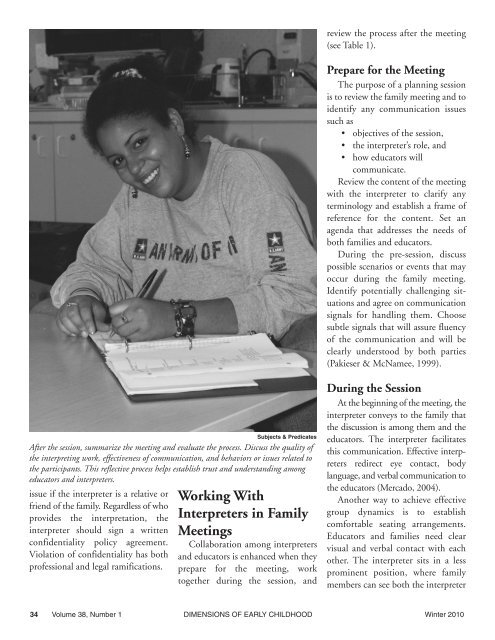90223 Dimensions Winter 10:Layout 1 - Southern Early Childhood ...
90223 Dimensions Winter 10:Layout 1 - Southern Early Childhood ...
90223 Dimensions Winter 10:Layout 1 - Southern Early Childhood ...
You also want an ePaper? Increase the reach of your titles
YUMPU automatically turns print PDFs into web optimized ePapers that Google loves.
eview the process after the meeting<br />
(see Table 1).<br />
Prepare for the Meeting<br />
The purpose of a planning session<br />
is to review the family meeting and to<br />
identify any communication issues<br />
such as<br />
• objectives of the session,<br />
• the interpreter’s role, and<br />
• how educators will<br />
communicate.<br />
Review the content of the meeting<br />
with the interpreter to clarify any<br />
terminology and establish a frame of<br />
reference for the content. Set an<br />
agenda that addresses the needs of<br />
both families and educators.<br />
During the pre-session, discuss<br />
possible scenarios or events that may<br />
occur during the family meeting.<br />
Identify potentially challenging situations<br />
and agree on communication<br />
signals for handling them. Choose<br />
subtle signals that will assure fluency<br />
of the communication and will be<br />
clearly understood by both parties<br />
(Pakieser & McNamee, 1999).<br />
Subjects & Predicates<br />
After the session, summarize the meeting and evaluate the process. Discuss the quality of<br />
the interpreting work, effectiveness of communication, and behaviors or issues related to<br />
the participants. This reflective process helps establish trust and understanding among<br />
educators and interpreters.<br />
issue if the interpreter is a relative or<br />
friend of the family. Regardless of who<br />
provides the interpretation, the<br />
interpreter should sign a written<br />
confidentiality policy agreement.<br />
Violation of confidentiality has both<br />
professional and legal ramifications.<br />
Working With<br />
Interpreters in Family<br />
Meetings<br />
Collaboration among interpreters<br />
and educators is enhanced when they<br />
prepare for the meeting, work<br />
together during the session, and<br />
During the Session<br />
At the beginning of the meeting, the<br />
interpreter conveys to the family that<br />
the discussion is among them and the<br />
educators. The interpreter facilitates<br />
this communication. Effective interpreters<br />
redirect eye contact, body<br />
language, and verbal communication to<br />
the educators (Mercado, 2004).<br />
Another way to achieve effective<br />
group dynamics is to establish<br />
comfortable seating arrangements.<br />
Educators and families need clear<br />
visual and verbal contact with each<br />
other. The interpreter sits in a less<br />
prominent position, where family<br />
members can see both the interpreter<br />
34 Volume 38, Number 1 DIMENSIONS OF EARLY CHILDHOOD <strong>Winter</strong> 20<strong>10</strong>
















